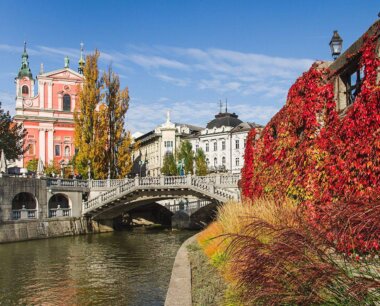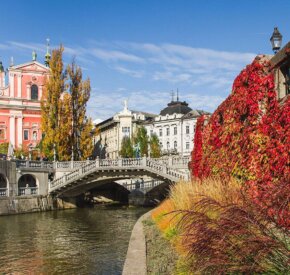
5 traditional ways to celebrate the summer solstice
Discover the weird and wonderful ways that different cultures celebrate the longest day of the year in the Northern Hemisphere, 21 June…
The summer solstice, aka the longest day of the year, is celebrated across the northern hemisphere.
While each country has their own unique take on celebrations, there are some common themes – which we’ve outlined below. Here are five traditional ways to mark the summer solstice this year.
1. Build a bonfire to deter evil spirits

A recurring feature in many summer solstice celebrations across Europe, it’s believed that lighting a bonfire deters evil spirits who roam freely as the sun turns south.
People in Estonia and Latvia believe that the fire scares mischievous harvest-ruining spirits, so the bigger the fire the further away the spirits keep (so the better the harvest will be). Estonians believe that not lighting a fire invites fire into the home, causing devastation.
In a similar vein, many customs also include burning a witch figure on top of the fire, usually made from straw and cloth, as it is believed that witches convene on solstice night. According to Danish folklore, this meeting occurs on Bloksbjerg, the Brocken mountain, and the burning ‘sends the witch away’.
Jumping over the bonfire is a popular tradition in places such as Croatia, Lithuania, Latvia, Estonia, Russia and Spain. In Spain, they shout ‘meigas!’, meaning ‘witches off!’, to bring prosperity.
Bulgaria has its own version of jumping over the fire with their Enyovden celebration (taking place on 24 June), which they believe marks the start of winter. Participants join a fire ritual involving dancing on smouldering embers, called Nestinarstvo.
Celebrations are held on Casper Mountain in Wyoming, USA, too. Revellers throw a handful of red soil into the bonfire, and believe it grants a wish.
2. Collect herbs and have a dance

These traditions stem from ideas of fertility, and the quest to find a husband or wife. Collecting summer flowers and herbs on the solstice evening, especially those believed to have potent medicinal properties, such as St John’s Wort, are common activities.
These bunches are hung in doorways or left in water overnight, to wash with the following morning. In Norway and Sweden, it is believed that placing flowers under the pillow of a young girl will make her dream of her future love.
In many places, it is believed that anyone seeing the sun rise will be healthy throughout the year. Due to the belief that medical and magical herbs have more potency before dawn, female ‘sorceresses’ and ‘enchantresses’ go to gather herbs by sunrise to cure and make charms.
In Romania, they perform the drăgaica, where young girls dance around a central girl dressed as a young bride.
3. Join Europe-wide Saint John’s Festival celebrations

One of the main reasons behind the solstice celebrations is the Christian marking of Saint John the Baptist’s birth. One of the only saint’s days to celebrate the birth of a saint, rather than the death, it is dated thus due to the Gospel of Luke in the Bible stating Saint John’s birthday to be six months before Jesus’s.
It comes under many different names such as Sankthansaften in Denmark, Jaanipäev in Estonia and Noite de São João in Portugal.
Brazil’s Festa Junina is a huge celebration in which regions compete for the biggest parties. Although it does not celebrate the solstice (as it’s actually their shortest day of the year), they will also celebrate the birth of Saint John.
It includes all of the bonfire, dancing and flower collecting traditions of solstice celebrations in the Northern Hemisphere – but they also erect a pau-de-sebo (maypole) and celebrate marital union.
The celebrations usually take place in a thatched-roof tent called an arraial. Men dress up as farm boys with large straw hats and women wear pigtails, freckles, painted gap teeth and red-checkered dresses, all in a loving tribute to the origins of Brazilian country music and their family beginnings.
Similarly, Portugal holds a street party with balloons and brightly coloured paper decorations. Strangely, they also bang each other over the head with rubber hammers for good luck.
4. See the sunrise at an ancient site

Perhaps one of the most famous summer solstice celebrations takes place at Stonehenge in England, with more than 15,000 people gathering each year to catch the sun rise behind the Heel Stone and shine straight into the centre of the circle, but it’s not the only ancient site that’s aligned with the longest day of the year.
Elsewhere in the UK, you can visit Avebury in Wiltshire; in Malta, you can watch the sunrise at Mnajdra Temple; and in the USA, you can head to Chaco Culture National Historical Park, and there are many more all over the world.
5. Watch a baseball game under the midnight sun

Held annually since 1906, the Midnight Sun Baseball Game in Alaska runs until the early hours – without the use of any artificial light.
As Fairbanks is incredibly close to the Arctic circle, the experiences the midnight sun phenomena whereby the sun fails to set between 22 April and 20 August each year.
If you’re looking for midnight sun in Europe, you’ll need to head to Norway, Sweden, Finland or Iceland, but you’ll have to organise your own teams as the baseball game is a Fairbanks exclusive (for now).
More information: explorefairbanks.com




















